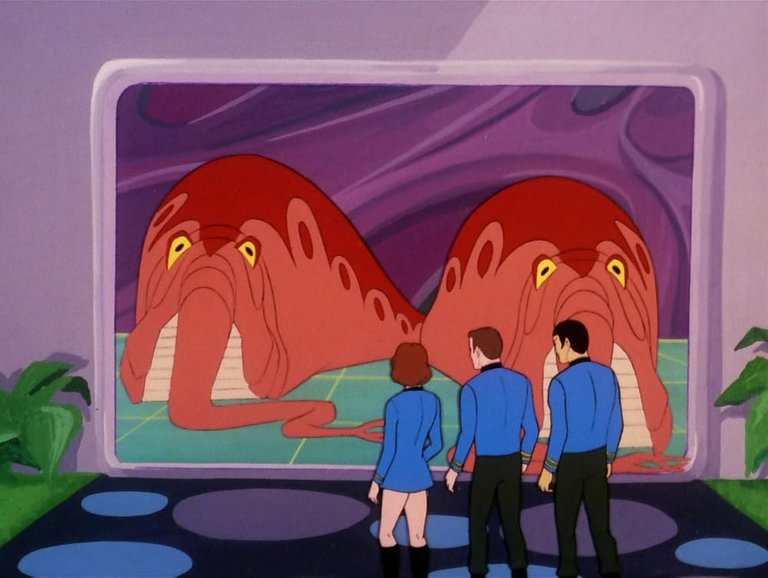Television Review: The Eye of the Beholder (Star Trek: The Animated Series, S1X15, 1974)

The Eye of the Beholder (S01E15)
Airdate: January 5th 1974
Written by: David P. Harmon
Directed by: Hal Sutherland
Running Time: 22 minutes
Science fiction is often celebrated as a genre that prioritises ideas over spectacle, a tradition epitomised by Star Trek. From its inception in The Original Series (TOS), Gene Roddenberry’s vision centred on using speculative concepts to explore humanity’s potential and pitfalls. This ethos carried over into Star Trek: The Animated Series (TAS), which leveraged animation to tackle stories that live-action practical effects might have struggled to realise. Yet, while the animated format offered creative freedom, it did not guarantee success. The Eye of the Beholder, a 1974 TAS episode written by David P. Harmon, exemplifies both the promise and the limitations of the series. Though it grapples with a thought-provoking premise about non-anthropocentric intelligence, the episode falters under its own ambition, failing to fully realise its potential as a landmark story.
The plot of The Eye of the Beholder follows the USS Enterprise to the planet Lactra VII, where a Federation science team has vanished. A distress message from Lieutenant Commander Markel reveals he investigated the disappearance of an away team before descending to the surface himself. Captain Kirk, Spock and McCoy beam down to the coordinates of the missing scientists, only to face immediate peril: giant, dinosaur-like creatures attack them. Amid the chaos, Spock notes the planet’s bizarre geography—a desert and lush rainforest inexplicably adjacent—a clue that artificial manipulation is at work. Captured and transported by strange slug-like creatures to an underground city, the trio find themselves in a zoo, perceived as unintelligent “pets” by the Lactrans. Spock attempts telepathic communication but realises the Lactrans are so advanced that human (and other) races appear to them as sub-sentient, akin to ants. Kirk’s cunning retrieval of a communicator sparks a rescue, but complications arise when a Lactran child is beamed aboard the Enterprise. Montgomery Scott’s rapport-building with the alien eventually resolves the misunderstanding, as the Lactrans concede that their “pets” are indeed sentient.
The episode’s core idea—questioning anthropocentrism by framing humanity as the “other”—is ambitious and resonant. Harmon’s script, building on Trek’s tradition of ethical dilemmas, challenges viewers to consider how truly alien minds might perceive intelligence. The animation proves vital here: the Lactrans’ bodies and the exotic architecture of their city visually reinforce their hyper-advanced, almost inhuman perspective. Spock’s comparison of humans to ants for the Lactrans is a concise yet potent metaphor, delivered in a manner accessible even to TAS’s younger audience. The episode also excels in its brevity, avoiding the over-explanation that often plagues Trek’s live-action counterparts, and focusing on the central conflict of perception versus reality.
However, these strengths are undercut by concessions to its target demographic. The first act’s inclusion of dinosaur-like monsters—a staple of children’s adventure tropes—feels jarring, tonally mismatched with the episode’s philosophical underpinnings. Worse, the survival of McCoy after being crushed by one of these creatures strains credulity, prioritising spectacle over coherence. Such narrative lapses undermine the episode’s seriousness, suggesting a lack of faith in its audience’s capacity to engage with subtlety. Additionally, the banter between Spock and McCoy grows increasingly antagonistic, a trend in TAS that diluted the characters’ mutual respect from TOS. While the dynamic occasionally produced wit, here it devolves into petty squabbles that distract from the story’s stakes.
Ultimately, The Eye of the Beholder is a competent but unspectacular entry in Trek’s animated canon. Its flaws—tonal inconsistency, plot contrivances, and strained character interactions—are forgivable in a 22-minute format, where pacing demands brevity. Yet, compared to TOS episodes like The Devil in the Dark (which similarly explored non-human intelligence), it feels derivative, lacking the nuance or emotional depth that might elevate it. The animation, while imaginative, cannot compensate for a script that prioritises kid-friendly thrills over thematic rigor.
For all its missteps, the episode remains a curiosity for completists and fans of Trek’s evolution. It underscores animation’s potential to visualise the impossible, even if its execution here is uneven. The Eye of the Beholder is a reminder that not every bold idea translates seamlessly to screen—and that even Star Trek, at its most experimental, could stumble in its pursuit of new frontiers.
RATING: 5/10 (++)
Blog in Croatian https://draxblog.com
Blog in English https://draxreview.wordpress.com/
InLeo blog https://inleo.io/@drax.leo
LeoDex: https://leodex.io/?ref=drax
InLeo: https://inleo.io/signup?referral=drax.leo
Hiveonboard: https://hiveonboard.com?ref=drax
Rising Star game: https://www.risingstargame.com?referrer=drax
1Inch: https://1inch.exchange/#/r/0x83823d8CCB74F828148258BB4457642124b1328e
BTC donations: 1EWxiMiP6iiG9rger3NuUSd6HByaxQWafG
ETH donations: 0xB305F144323b99e6f8b1d66f5D7DE78B498C32A7
BCH donations: qpvxw0jax79lhmvlgcldkzpqanf03r9cjv8y6gtmk9